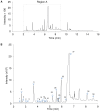Tualang honey improves human corneal epithelial progenitor cell migration and cellular resistance to oxidative stress in vitro
- PMID: 24802273
- PMCID: PMC4011849
- DOI: 10.1371/journal.pone.0096800
Tualang honey improves human corneal epithelial progenitor cell migration and cellular resistance to oxidative stress in vitro
Erratum in
- PLoS One. 2014;9(8):e105233
Abstract
Stem cells with enhanced resistance to oxidative stress after in vitro expansion have been shown to have improved engraftment and regenerative capacities. Such cells can be generated by preconditioning them with exposure to an antioxidant. In this study we evaluated the effects of Tualang honey (TH), an antioxidant-containing honey, on human corneal epithelial progenitor (HCEP) cells in culture. Cytotoxicity, gene expression, migration, and cellular resistance to oxidative stress were evaluated. Immunofluorescence staining revealed that HCEP cells were holoclonal and expressed epithelial stem cell marker p63 without corneal cytokeratin 3. Cell viability remained unchanged after cells were cultured with 0.004, 0.04, and 0.4% TH in the medium, but it was significantly reduced when the concentration was increased to 3.33%. Cell migration, tested using scratch migration assay, was significantly enhanced when cells were cultured with TH at 0.04% and 0.4%. We also found that TH has hydrogen peroxide (H2O2) scavenging ability, although a trace level of H2O2 was detected in the honey in its native form. Preconditioning HCEP cells with 0.4% TH for 48 h showed better survival following H2O2-induced oxidative stress at 50 µM than untreated group, with a significantly lower number of dead cells (15.3 ± 0.4%) were observed compared to the untreated population (20.5 ± 0.9%, p<0.01). Both TH and ascorbic acid improved HCEP viability following induction of 100 µM H2O2, but the benefit was greater with TH treatment than with ascorbic acid. However, no significant advantage was demonstrated using 5-hydroxymethyl-2-furancarboxaldehyde, a compound that was found abundant in TH using GC/MS analysis. This suggests that the cellular anti-oxidative capacity in HCEP cells was augmented by native TH and was attributed to its antioxidant properties. In conclusion, TH possesses antioxidant properties and can improve cell migration and cellular resistance to oxidative stress in HCEP cells in vitro.
Conflict of interest statement
Figures







Similar articles
-
Comparison of culture media for ex vivo cultivation of limbal epithelial progenitor cells.Mol Vis. 2013;19:69-77. Epub 2013 Jan 17. Mol Vis. 2013. PMID: 23378720 Free PMC article.
-
A comparison of stem cell-related gene expression in the progenitor-rich limbal epithelium and the differentiating central corneal epithelium.Mol Vis. 2011;17:2102-17. Epub 2011 Aug 10. Mol Vis. 2011. PMID: 21850186 Free PMC article.
-
Tualang honey has higher phenolic content and greater radical scavenging activity compared with other honey sources.Nutr Res. 2011 Apr;31(4):322-5. doi: 10.1016/j.nutres.2011.03.001. Epub 2011 Apr 13. Nutr Res. 2011. PMID: 21530807
-
[Identification, purification and culture of limbal epithelial stem cells].Sheng Wu Yi Xue Gong Cheng Xue Za Zhi. 2009 Apr;26(2):452-6. Sheng Wu Yi Xue Gong Cheng Xue Za Zhi. 2009. PMID: 19499824 Review. Chinese.
-
Identification and characterization of limbal stem cells.Exp Eye Res. 2005 Sep;81(3):247-64. doi: 10.1016/j.exer.2005.02.016. Exp Eye Res. 2005. PMID: 16051216 Review.
Cited by
-
The stingless bee honey protects against hydrogen peroxide-induced oxidative damage and lipopolysaccharide-induced inflammation in vitro.Saudi J Biol Sci. 2021 May;28(5):2987-2994. doi: 10.1016/j.sjbs.2021.02.039. Epub 2021 Feb 18. Saudi J Biol Sci. 2021. PMID: 34025176 Free PMC article.
-
Physicochemical and Medicinal Properties of Tualang, Gelam and Kelulut Honeys: A Comprehensive Review.Nutrients. 2021 Jan 10;13(1):197. doi: 10.3390/nu13010197. Nutrients. 2021. PMID: 33435215 Free PMC article. Review.
-
Medicinal activities of Tualang honey: a systematic review.BMC Complement Med Ther. 2024 Oct 4;24(1):358. doi: 10.1186/s12906-024-04664-2. BMC Complement Med Ther. 2024. PMID: 39367403 Free PMC article.
-
Honey-incorporated nanofibre reduces replicative senescence of umbilical cord-derived mesenchymal stem cells.IET Nanobiotechnol. 2020 Dec;14(9):870-880. doi: 10.1049/iet-nbt.2019.0288. IET Nanobiotechnol. 2020. PMID: 33399121 Free PMC article.
-
The anti-cancer effects of Tualang honey in modulating breast carcinogenesis: an experimental animal study.BMC Complement Altern Med. 2017 Apr 11;17(1):208. doi: 10.1186/s12906-017-1721-4. BMC Complement Altern Med. 2017. PMID: 28399853 Free PMC article.
References
Publication types
MeSH terms
Substances
LinkOut - more resources
Full Text Sources
Other Literature Sources
Medical
Miscellaneous

